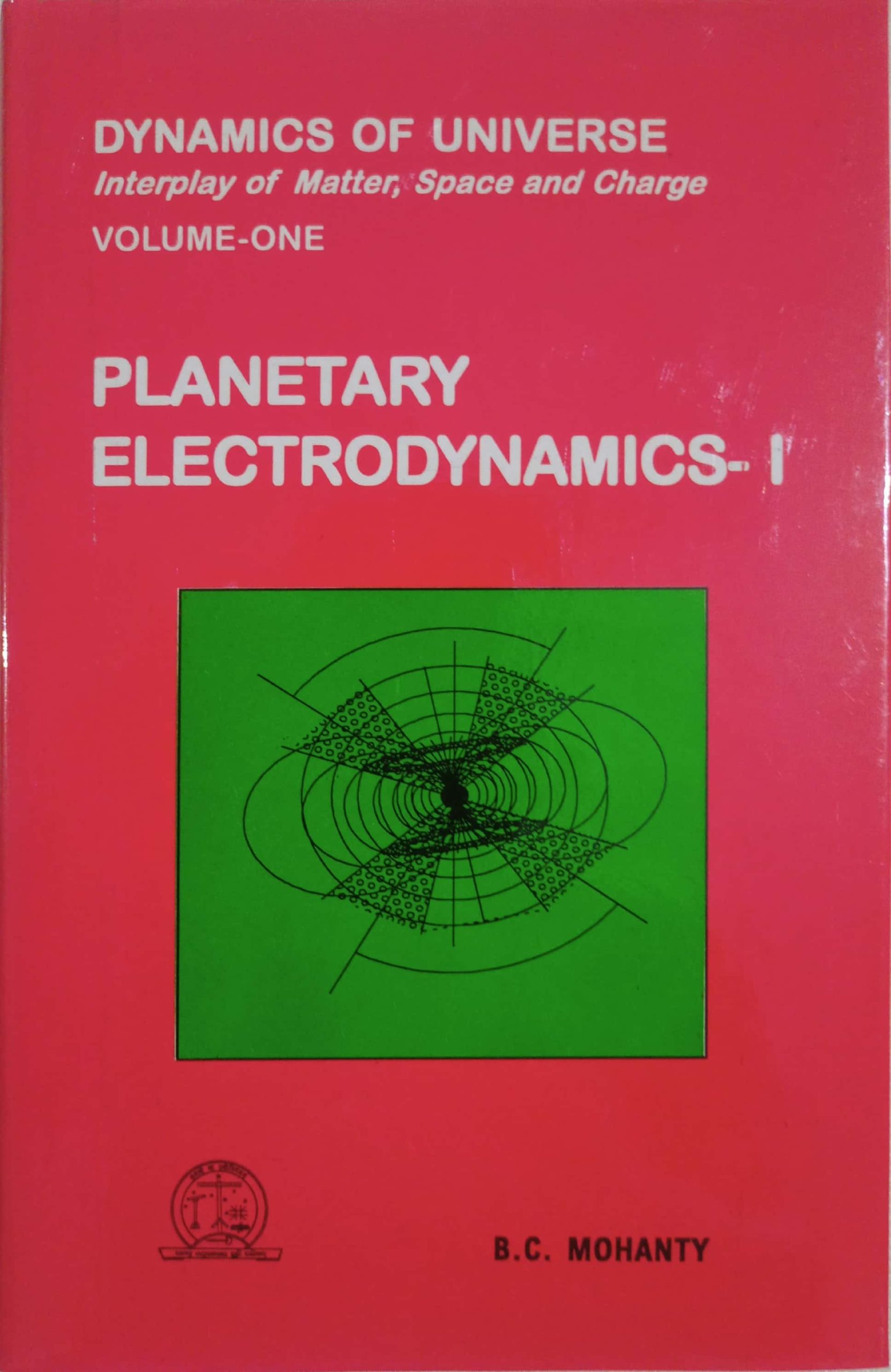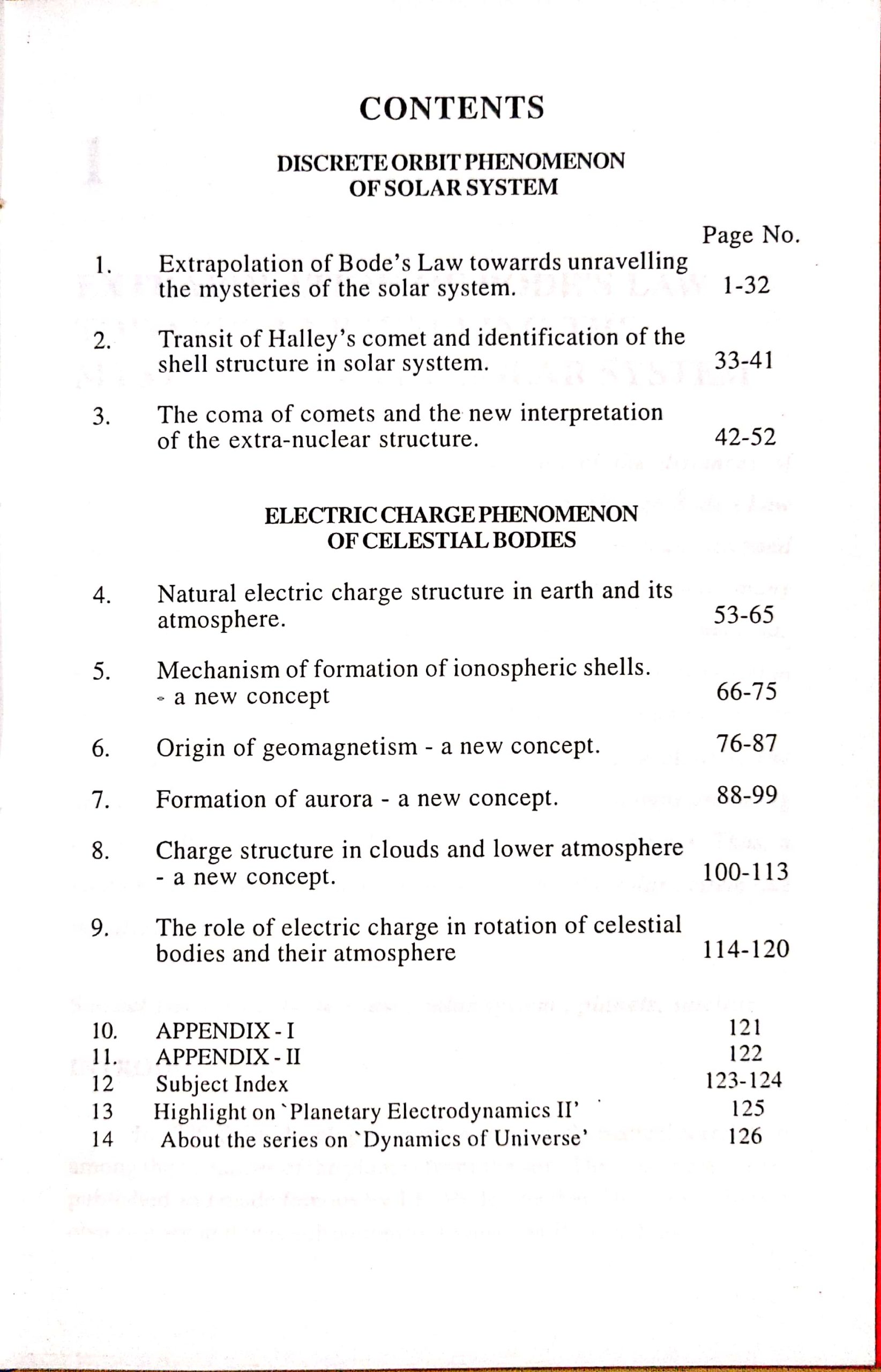INSTITUTE OF PHILOSOPHY OF NATURE






Our Books
Volume I - PLANETARY ELECTRODYNAMICS – I
About this book
Preface


DYNAMICS OF UNIVERSE: Interplay of Matter, Space and Charge, VOLUME-one (PLANETARY ELECTRODYNAMICS – I)
DISCRETE ORBIT PHENOMENON OF SOLAR SYSTEM
“Super unification of the fundamental forces of nature is nothing less than possessing the key of the universe” says Prof. Paul Davies, the author of the book ‘Super Force’. The value of the key is enormously high as it opens the way by unfolding nature to reveal its secrets. There is a consistent effort by top class scientists of the world to find this key. After a century of long search when the key could not be traced, then the focus changed from the key to a set of quantum numbers assuming that nature operates an inscrutable number lock. Here a question may arise – is this amount of effort and the lapse of time not enough to unravel the mysteries of nature ? At the same time, many think, nature may be simple and perhaps not so complicated as scientists have thought it to be. This gives a feeling that nature is open to all and no lock operates anywhere in any domain. Thus, the barrier faced in frontier science is only man-made and the same therefore can be removed by man only. We find a large number of unrealistic hypotheses have been made while studying the norms of nature in different domains of the universe. However unrealistic an assumption may appear, it enters and gets established through the support of a man-made law in a limited frame of reference. The so framed laws have their field of operation in a limited spectrum and they fail beyond their set limits. Even the universal law of gravity framed in the solar system domain fails to explain the gravity based dynamics in the galactic domain if one doesn’t invite the hidden mass concept. Thus, rightly says Dr. Moto Milgrom, “it is the hidden physics and not the hidden mass required to understand how a galaxy moves” in his article `Newton Gravity Falls Down’ (New Scientist 7 March 1985). The hypotheses which were made to formulate theories in their local frames assumed a peculiar impression even beyond the limits of the operational range of these theories and gave rise to the erroneous notions. This is why scientists working in different domains differ in their perception about nature. Research workers pursuing research in classical theory, quantum theory, particle theory, wave theory, mass attraction gravity, space time gravity, quantum gravity, micro domain, macro domain, homeopathic dilution etc. differ greatly as they carry different domain based perception to the understanding of nature.
In view of the above, a harmonious unification of different perceptions towards the reality of nature is essential before any attempt for the unification of fundamental forces and the dynamics in different domains is made. This requires a homogeneous understanding of different entities of nature that constitute the system in different domains. When this is done, perhaps, all theories will take birth with unification in-situ. The proposed unified understanding is feasible at the expense of some established concepts in science, those standing in the way of such unification. Such a drastic step is possible only when one is determined to have it, come what may. The author foresees wide applications of the new concept as it simplifies much scientific analysis and therefore has brought out the articles of this volume to supplement this new concept.
Previously, various models of the atomic system had been proposed but the one that borrowed the orbital concept from the solar system and applied to atomic electrons only led to success. The success in concept-grafting made the scientists work seriously for additional matching of features between the two domains. When all attempts failed to build up any further linkage it was concluded that the two systems in two domains are basically different in their structure and dynamics and thereafter work in this direction did not seem to progress further. At this juncture, one may also think the two systems to be similar and utilize their differences as a good source of information for proper augmentation of both systems (atomic and solar systems). Among many differences, the most vital one is the difference in the existence of the basic entities, i.e., the nucleus and electrons in the atomic system carry electric charge whereas the sun and the planets of the solar system do not carry electric charge. One who looks at the negative aspect may say- there is no scope of having one to one correspondence between the systems in the two domains because the celestial bodies are not charged. On the other hand, this negative aspect can be taken as a positive base by an optimist who thinks he has the scope of adopting the electric charge concept for the celestial bodies. In view of this, we may have to wait some more time before having the final word in the search for similarities between micro and macro domains.
The first three articles of this book are meant to establish the discrete orbit system for the orbital bodies of the solar system and the existence of a shell structure through the typical interaction of Halley’s Comet. The subsequent six articles explain the observed charge phenomena on the surface and in the atmosphere of the earth from the new charge concept of celestial bodies. Many unsolved problems related to electric charge in thunderclouds, ionosphere, aurora, and the formation of geomagnetism, Van Allen belt, magnetosphere etc. may now be understood clearly from the new charge concept. The reasons for the formation of energy wells in the gravitational field that makes the discrete orbit may be understood from the combined action of gravity and the electric charge interaction forces.
A harmonious understanding by resolving the existing differences between the atomic and the solar system appears feasible particularly when the same fundamental entities are assumed to be present in both the systems.
I wish to add that the views expressed in the articles of this volume are exclusively mine in the capacity of individual scientists and do not necessarily represent the views of the organization for which I work or worked in the past.
B.C. Mohanty
PLANETARY ELECTRODYNAMICS-I has answers to the following questions
◼ Can we discover discrete nature of orbits of orbital bodies in solar system?
◼ Is there a natural electric and thermal field structure surrounding every celestial body?
◼ Is it possible to understand the exact nature of ionosphere and its peculiarities including the observed peak at mid-night?
◼ Is it possible to understand geomagnetism through simpler electromagnetism as against the present understanding of less feasible magneto hydrodynamics operating at core of the earth?
◼ Can we understand the formation of auroral oval in a better manner as the observed charge field features go against the basic assumption of the dynamo theory?
◼ Is the electric charge structure in clouds and lower atmosphere of the earth linked to some more fundamental aspects of the planet as against less convincing theories based on convection and precipitation models?
◼ Can we expect a kind of charge interaction in the dynamics of solar system due to naturally standing charge structure?
Read our Journal 'Towards Unification of Sciences'
The journal publishes brainstorming articles on new and break through ideas, concepts and theories.
